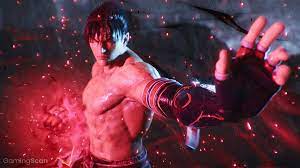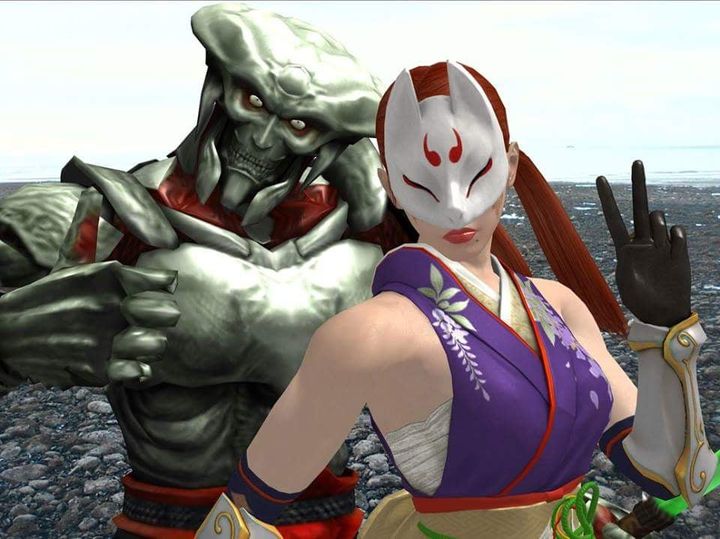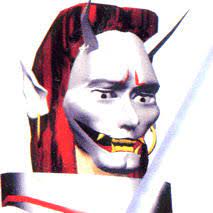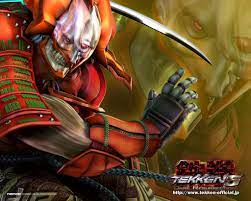Japanese Folklore in Tekken Characters: Yoshimitsu and Kunimitsu
 Representatives of Japanese folklore in Tekken series
Representatives of Japanese folklore in Tekken series
Representatives of Japanese Folklore in the Tekken Series The Tekken game series, initiated in 1994 by Namco, quickly became one of the most recognizable and esteemed brands in the fighting game world. Its unique blend of intense action, advanced gameplay mechanics, and a wide array of colorful characters has endeared it to players globally. Over the years, Tekken has evolved, introducing new elements to its formula while remaining true to its roots and ensuring that each new installment is a celebration for fans.
Among the diverse characters Tekken has to offer, two stand out for their unique connection to Japanese culture and tradition – Yoshimitsu and Kunimitsu. These characters are excellent examples of how elements of Japanese folklore can be successfully woven into the world of video games, creating fascinating and multidimensional personas. Both draw from a rich palette of Japanese myths, legends, and samurai history, transforming these traditional motifs into something fresh and exciting for players worldwide.

Yoshimitsu: The Futuristic Warrior with Tradition
The Name Yoshimitsu
Yoshimitsu, one of the most iconic characters in the Tekken game series, is a rich amalgamation of Japanese tradition and futuristic innovation. His name, 吉光 (Yoshimitsu), translates to "Good Light" or "Fortunate Glow," an intriguing choice for a character so deeply rooted in samurai aesthetics. “吉” (yoshi) is often associated with luck and prosperity, while “光” (mitsu) translates to light or glow, together creating a positive and energetic image.
Yoshimitsu, a character renowned from the Tekken series, is a tapestry of Japanese folklore, history, and samurai culture. Numerous references to the traditions of the Land of the Rising Sun are visible in his appearance and behavior.
In Japanese history, there is another Yoshimitsu - Ashikaga Yoshimitsu. He was the third shogun of the Ashikaga dynasty, ruling from 1368 to 1394. His reign is remembered as a time of stabilization and peace, as well as a period during which Japanese culture significantly developed, especially in the fields of art and architecture. Yoshimitsu was also a known patron of the arts, and his reign fostered the development of traditional Japanese art forms. However, there is no indication that Yoshimitsu from Tekken is a reference to this historical figure.
 Yoshimitsu’s Samurai Attire
Yoshimitsu’s Samurai Attire
In terms of attire, Yoshimitsu wears armor reminiscent of traditional samurai armor (yoroi). Distinctive elements such as the kabuto (helmet) with ornamental features and the dō (the part of the armor protecting the torso) are clearly visible. Additionally, his costumes often incorporate elements referring to ninja culture, such as a face mask and the special tabi footwear, which is a nod to the mysterious shadow warriors.
The sword
Yoshimitsu wields, although not a direct reference to any specific historical weapon, draws from the famous Japanese katana. His ability to manipulate energy, allowing him to perform supernatural attacks, can be seen as a reference to shugendō – an ascetic, mountain-based Buddhist practice whose followers believe in the possibility of acquiring supernatural powers.

 Yoshimitsu’s History
Yoshimitsu’s History
In the Tekken universe, Yoshimitsu serves as the enigmatic leader of the Manji Clan, a group of thieves that steals from the rich to support the poor. This character is both noble and unpredictable, and his story draws upon numerous themes from Japanese folklore. The message “steal from the rich, give to the poor” strongly resonates with the tales of Robin Hood, but it also finds its roots in Japanese folk tales about heroic figures such as Ishikawa Goemon, who was purportedly the Japanese equivalent of Robin Hood. Goemon, like Yoshimitsu, was a contradictory figure—he was a thief, but also considered a hero of the people, which has caused his legend to live on in Japanese culture to this day.

Yoshimitsu’s characteristic ability to teleport and other supernatural skills are reminiscent of stories about tengu, creatures that, according to Japanese beliefs, have the ability to manipulate time and space. His unpredictability and agility in battle are also characteristic of ninjas, a group of warriors known in Japanese history for their unique combat techniques and espionage skills. In terms of morality and social justice, Yoshimitsu mirrors the heroes of Japanese folk tales, who often stood against injustice and helped the poor.
Yoshi's Masks
Yoshimitsu is a character in the Tekken series who stands out not only for his unique fighting skills but also for his distinctive appearance, which includes various masks worn by him in different installments of the game. Below is an analysis of his masks with reference to Japanese folklore and other cultural aspects.
 Tekken 1: Yoshimitsu's first mask draws from traditional samurai masks. Its design reflects the stern and majestic face of a warrior, tying into the bushi culture and the samurai ideal.
Tekken 1: Yoshimitsu's first mask draws from traditional samurai masks. Its design reflects the stern and majestic face of a warrior, tying into the bushi culture and the samurai ideal.
 Tekken 2: In the second installment of the series, Yoshimitsu's mask evolves, taking on a more mystical and exotic appearance. Elements reminiscent of masks used in traditional Japanese Nō theater appear, highlighting the dramatic and theatrical aspect of his character.
Tekken 2: In the second installment of the series, Yoshimitsu's mask evolves, taking on a more mystical and exotic appearance. Elements reminiscent of masks used in traditional Japanese Nō theater appear, highlighting the dramatic and theatrical aspect of his character.
 Tekken 3: In the third installment of the Tekken series, Yoshimitsu's mask becomes even more fantastical, taking on characteristics reminiscent of yōkai – supernatural beings from Japanese folklore. This reference to yōkai emphasizes Yoshimitsu's mysterious and supernatural nature. It is often noted that Yoshimitsu’s appearance in T3 has features similar to an alien, otherworldly.
Tekken 3: In the third installment of the Tekken series, Yoshimitsu's mask becomes even more fantastical, taking on characteristics reminiscent of yōkai – supernatural beings from Japanese folklore. This reference to yōkai emphasizes Yoshimitsu's mysterious and supernatural nature. It is often noted that Yoshimitsu’s appearance in T3 has features similar to an alien, otherworldly.
 Tekken 4: In Tekken 4, Yoshimitsu's mask takes on a futuristic look, reflecting the influence of technology on the game's world. However, elements inspired by Japanese tradition can still be seen, symbolizing the combination of modernity and history in Yoshimitsu's character.
Tekken 4: In Tekken 4, Yoshimitsu's mask takes on a futuristic look, reflecting the influence of technology on the game's world. However, elements inspired by Japanese tradition can still be seen, symbolizing the combination of modernity and history in Yoshimitsu's character.
 Tekken 5: In this installment of the series, Yoshimitsu's mask takes on a more organic shape, potentially referencing Shintō – Japan's indigenous religion that venerates nature and its forces. Masks in Shintō often depict animals or elements of nature, which can be found in the design of Yoshimitsu's masks in Tekken 5.
Tekken 5: In this installment of the series, Yoshimitsu's mask takes on a more organic shape, potentially referencing Shintō – Japan's indigenous religion that venerates nature and its forces. Masks in Shintō often depict animals or elements of nature, which can be found in the design of Yoshimitsu's masks in Tekken 5.
 Tekken 6: In Tekken 6, Yoshimitsu's mask is even more extravagant and unique, possibly reflecting his unique role in the Tekken universe. Elements of theatrical masks and motifs related to folklore are still present, emphasizing his connections to Japanese culture.
Tekken 6: In Tekken 6, Yoshimitsu's mask is even more extravagant and unique, possibly reflecting his unique role in the Tekken universe. Elements of theatrical masks and motifs related to folklore are still present, emphasizing his connections to Japanese culture.
In Tekken 7, Yoshimitsu's masks incorporate elements reminiscent of various characters and motifs from Japanese folklore, giving his appearance a multi-dimensional character:
Oni (鬼): Demonic beings often found in Japanese folk stories. Yoshimitsu's mask in Tekken 7 has elements reminiscent of carved oni masks, especially in facial expression and exaggerated features.
Tengu (天狗): Supernatural beings often depicted with long noses and red faces. Tengu masks are popular in Japanese Nō and Kabuki theater. Elements of this creature can be seen in Yoshimitsu's mask, emphasizing his connections to traditional Japanese theater.
 Kabuto (兜, 冑): Traditional Japanese samurai helmets, which could have ornamental elements inspired by mythology and folklore. Yoshimitsu's helmet design in Tekken 7 may reference this tradition, combining the warrior legacy of the samurai with artistic motifs.
Kabuto (兜, 冑): Traditional Japanese samurai helmets, which could have ornamental elements inspired by mythology and folklore. Yoshimitsu's helmet design in Tekken 7 may reference this tradition, combining the warrior legacy of the samurai with artistic motifs.
Hannya (般若): Masks representing women transformed into demons by intense emotions such as jealousy or rage. While Yoshimitsu’s mask may not be a direct representation of the Hannya mask, its expressiveness and wild features may draw from this type of depiction.
Futuristic and Cyberpunk Themes: In addition to traditional elements, Yoshimitsu's mask in Tekken 7 also incorporates futuristic and cyberpunk themes, reflecting contemporary interpretations and reinventions of Japanese aesthetics.
Kunimitsu: The Mysterious Warrior
 The Name Kunimitsu
The Name Kunimitsu
The name “Kunimitsu,” written in kanji as 國光, can be interpreted as "light of the nation" or "glory of the country." It is a name found amongst both men and women in Japan, and its sound and meaning may suggest a kind of national pride or service to the country.
Kunimitsu’s Story
Within the Tekken universe, Kunimitsu takes on the role of a mysterious and agile kunoichi, simultaneously an experienced thief and a veiled warrior. Her story is tightly connected with the Manji clan, where she served under the leadership of Yoshimitsu, before eventually deciding to forge her own path. The motif of a ninja woman deciding to live life on her own terms can be found in numerous Japanese tales and legends, which often depict kunoichi as independent, cunning, and mysterious characters. Their abilities to manipulate and disguise, as well as their mastery in combat, make them fascinating heroines of folklore.

Who Are the Kunoichi?
 "Kunoichi” is a Japanese term used to describe female ninjas. In the past, during the feudal periods of Japan, kunoichi played various roles, including espionage, assassination, and sabotage. Though they were as well-trained in the martial arts as their male counterparts, the ninja, they often used different methods and techniques to achieve their goals.
"Kunoichi” is a Japanese term used to describe female ninjas. In the past, during the feudal periods of Japan, kunoichi played various roles, including espionage, assassination, and sabotage. Though they were as well-trained in the martial arts as their male counterparts, the ninja, they often used different methods and techniques to achieve their goals.

In modern times, kunoichi have become a popular motif in Japanese pop culture, appearing in anime, manga, films, and video games. They offer a unique blend of strength, agility, and mystery, making them fascinating characters. In the Tekken series, Kunimitsu is an example of a kunoichi character, showcasing these characteristic traits and skills in the game.
Kunimitsu’s Attire

On her head, Kunimitsu wears a mask, a characteristic element for ninja characters. This mask, known as men-yoroi, was originally part of samurai armor but was adapted by ninjas for camouflage purposes and to protect their identity. Additionally, her appearance features armed gloves and tabi boots, which on one hand increase her grip and stability during combat, and on the other hand, reference traditional ninja footwear. Therefore, Kunimitsu’s entire outfit represents a combination of elements from various aspects of Japanese martial tradition, reflecting both the mystery and cunning of kunoichi, as well as the honor and strength of samurais.
Summary
Tekken, being one of the most recognizable fighting game series in the world, has significantly contributed to the popularization of Japanese culture and folklore in the global video game market. Characters such as Yoshimitsu and Kunimitsu, deeply rooted in the tradition of the Land of the Rising Sun, serve as excellent examples of how historical and cultural elements can be effectively woven into modern digital entertainment. Their unique stories, fighting styles, and outfits not only capture players’ attention with their visual appeal but also educate about the richness of Japanese samurai, ninja, and other cultural traditions. This blend of history and entertainment ensures that Tekken remains not just a game but also a medium of cultural transmission, capable of speaking to players worldwide.

A connoisseur of Asian culture with a deep-seated appreciation for various philosophies of the world. By education, psychologist and Korean philologist. By heart, an Android developer and an ardent tech aficionado. In tranquil moments, he champions a disciplined way of life, firmly believing that steadfastness, perpetual self-enhancement, and a dedication to one's passions is a sensible path for life.
Personnal Motto:
"The most powerful force in the universe is compound interest." - Albert Einstein (possibly)
Mike Soray
(aka Michał Sobieraj)
Contact Us...
Ciechanow, Poland
dr.imyon@gmail.com
___________________
inari.smart
Have insights or feedback to share about the site or the apps? Drop us a note, and we'll be in touch soon. We value your perspective!
 Representatives of Japanese folklore in Tekken series
Representatives of Japanese folklore in Tekken series Yoshimitsu’s History
Yoshimitsu’s History Tekken 1: Yoshimitsu's first mask draws from traditional samurai masks. Its design reflects the stern and majestic face of a warrior, tying into the bushi culture and the samurai ideal.
Tekken 1: Yoshimitsu's first mask draws from traditional samurai masks. Its design reflects the stern and majestic face of a warrior, tying into the bushi culture and the samurai ideal. Tekken 2: In the second installment of the series, Yoshimitsu's mask evolves, taking on a more mystical and exotic appearance. Elements reminiscent of masks used in traditional Japanese Nō theater appear, highlighting the dramatic and theatrical aspect of his character.
Tekken 2: In the second installment of the series, Yoshimitsu's mask evolves, taking on a more mystical and exotic appearance. Elements reminiscent of masks used in traditional Japanese Nō theater appear, highlighting the dramatic and theatrical aspect of his character. Tekken 3: In the third installment of the Tekken series, Yoshimitsu's mask becomes even more fantastical, taking on characteristics reminiscent of yōkai – supernatural beings from Japanese folklore. This reference to yōkai emphasizes Yoshimitsu's mysterious and supernatural nature. It is often noted that Yoshimitsu’s appearance in T3 has features similar to an alien, otherworldly.
Tekken 3: In the third installment of the Tekken series, Yoshimitsu's mask becomes even more fantastical, taking on characteristics reminiscent of yōkai – supernatural beings from Japanese folklore. This reference to yōkai emphasizes Yoshimitsu's mysterious and supernatural nature. It is often noted that Yoshimitsu’s appearance in T3 has features similar to an alien, otherworldly. Tekken 4: In Tekken 4, Yoshimitsu's mask takes on a futuristic look, reflecting the influence of technology on the game's world. However, elements inspired by Japanese tradition can still be seen, symbolizing the combination of modernity and history in Yoshimitsu's character.
Tekken 4: In Tekken 4, Yoshimitsu's mask takes on a futuristic look, reflecting the influence of technology on the game's world. However, elements inspired by Japanese tradition can still be seen, symbolizing the combination of modernity and history in Yoshimitsu's character. Tekken 5: In this installment of the series, Yoshimitsu's mask takes on a more organic shape, potentially referencing Shintō – Japan's indigenous religion that venerates nature and its forces. Masks in Shintō often depict animals or elements of nature, which can be found in the design of Yoshimitsu's masks in Tekken 5.
Tekken 5: In this installment of the series, Yoshimitsu's mask takes on a more organic shape, potentially referencing Shintō – Japan's indigenous religion that venerates nature and its forces. Masks in Shintō often depict animals or elements of nature, which can be found in the design of Yoshimitsu's masks in Tekken 5. Tekken 6: In Tekken 6, Yoshimitsu's mask is even more extravagant and unique, possibly reflecting his unique role in the Tekken universe. Elements of theatrical masks and motifs related to folklore are still present, emphasizing his connections to Japanese culture.
Tekken 6: In Tekken 6, Yoshimitsu's mask is even more extravagant and unique, possibly reflecting his unique role in the Tekken universe. Elements of theatrical masks and motifs related to folklore are still present, emphasizing his connections to Japanese culture. Kabuto (兜, 冑): Traditional Japanese samurai helmets, which could have ornamental elements inspired by mythology and folklore. Yoshimitsu's helmet design in Tekken 7 may reference this tradition, combining the warrior legacy of the samurai with artistic motifs.
Kabuto (兜, 冑): Traditional Japanese samurai helmets, which could have ornamental elements inspired by mythology and folklore. Yoshimitsu's helmet design in Tekken 7 may reference this tradition, combining the warrior legacy of the samurai with artistic motifs.  The Name Kunimitsu
The Name Kunimitsu  "Kunoichi” is a Japanese term used to describe female ninjas. In the past, during the feudal periods of Japan, kunoichi played various roles, including espionage, assassination, and sabotage. Though they were as well-trained in the martial arts as their male counterparts, the ninja, they often used different methods and techniques to achieve their goals.
"Kunoichi” is a Japanese term used to describe female ninjas. In the past, during the feudal periods of Japan, kunoichi played various roles, including espionage, assassination, and sabotage. Though they were as well-trained in the martial arts as their male counterparts, the ninja, they often used different methods and techniques to achieve their goals.
